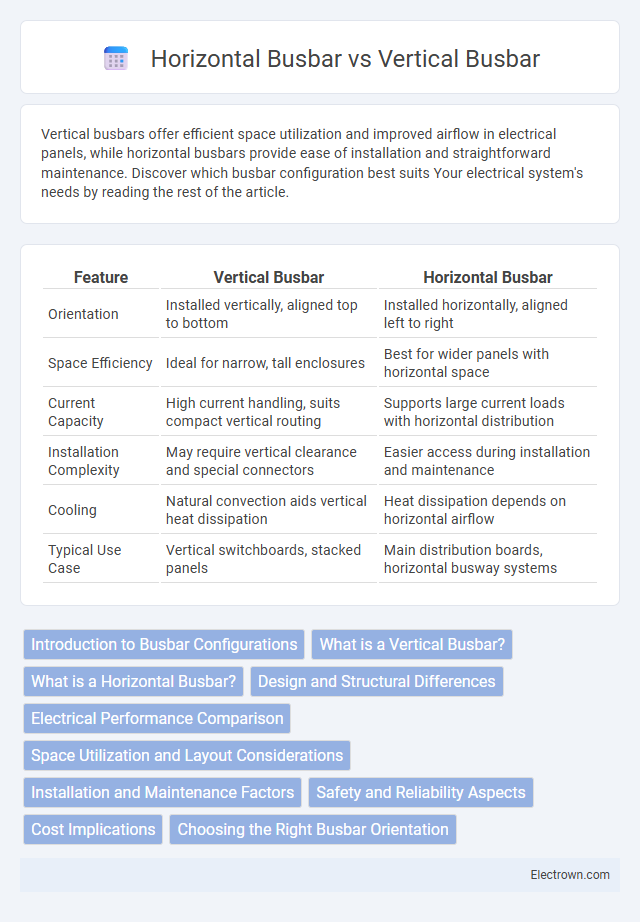Vertical busbars offer efficient space utilization and improved airflow in electrical panels, while horizontal busbars provide ease of installation and straightforward maintenance. Discover which busbar configuration best suits Your electrical system's needs by reading the rest of the article.
Table of Comparison
| Feature | Vertical Busbar | Horizontal Busbar |
|---|---|---|
| Orientation | Installed vertically, aligned top to bottom | Installed horizontally, aligned left to right |
| Space Efficiency | Ideal for narrow, tall enclosures | Best for wider panels with horizontal space |
| Current Capacity | High current handling, suits compact vertical routing | Supports large current loads with horizontal distribution |
| Installation Complexity | May require vertical clearance and special connectors | Easier access during installation and maintenance |
| Cooling | Natural convection aids vertical heat dissipation | Heat dissipation depends on horizontal airflow |
| Typical Use Case | Vertical switchboards, stacked panels | Main distribution boards, horizontal busway systems |
Introduction to Busbar Configurations
Busbars serve as critical electrical conductors in power distribution, with vertical and horizontal configurations tailored for different installation needs. Vertical busbars optimize space and improve heat dissipation in tall switchgear panels, while horizontal busbars offer easier access for maintenance and flexibility in connecting multiple circuits. Understanding these distinctions helps you choose the ideal busbar layout that enhances system efficiency and reliability.
What is a Vertical Busbar?
A vertical busbar is an electrical conductor system designed to efficiently distribute power vertically within switchgear panels or electrical cabinets. Typically made of copper or aluminum, vertical busbars provide a compact, organized pathway for current flow between circuit breakers and other components, optimizing space and heat dissipation. Their vertical alignment enhances accessibility for maintenance and allows for easy expansion in modular electrical systems.
What is a Horizontal Busbar?
A Horizontal Busbar is a crucial electrical conductor designed to distribute power efficiently across panels, running parallel to the ground for easy access and installation. It supports modular setups and reduces electromagnetic interference, enhancing system reliability and performance. Commonly used in switchgear and distribution boards, its compact design optimizes space in electrical enclosures.
Design and Structural Differences
Vertical busbars are designed to efficiently distribute electrical power in tall, multi-story buildings by aligning parallel to the building's height, which optimizes space and minimizes voltage drop. Horizontal busbars run perpendicular to the building's height and are commonly used in wider, single-story layouts, providing easier access for maintenance and straightforward integration with electrical panels. Understanding these design and structural differences helps you select the busbar system that best fits your building's configuration and electrical load requirements.
Electrical Performance Comparison
Vertical busbars typically offer superior electrical performance due to enhanced heat dissipation and reduced inductance, which leads to lower voltage drop and improved current carrying capacity. Horizontal busbars, while easier to install in limited vertical space, tend to exhibit higher resistance and increased electromagnetic interference due to longer current paths and less effective cooling. Choosing vertical busbars often results in optimized efficiency and reliability in high-power electrical systems.
Space Utilization and Layout Considerations
Vertical busbars maximize space utilization by occupying less horizontal area, making them ideal for installations with limited width but ample vertical clearance. Horizontal busbars simplify layout and wiring access, often preferred in equipment rooms with wider footprints and easier maintenance requirements. Your choice between vertical and horizontal busbars should consider the available space constraints and accessibility needs for efficient electrical system design.
Installation and Maintenance Factors
Vertical busbars offer easier installation in compact spaces due to their alignment with building structures, reducing the need for extensive support frameworks. Maintenance of vertical busbars is generally straightforward because of better accessibility in vertical panels, enabling quicker inspection and fault detection. Horizontal busbars require more horizontal space and support, which can complicate installation but may facilitate heat dissipation and allow for modular maintenance in larger switchgear assemblies.
Safety and Reliability Aspects
Vertical busbars offer enhanced safety by reducing exposure to electrical faults through improved insulation and compact design, minimizing the risk of accidental contact. Horizontal busbars provide reliable heat dissipation due to their expanded surface area, which helps maintain consistent performance and prevent overheating. Your choice between vertical and horizontal busbars should consider these safety and reliability factors to ensure optimal electrical system protection and longevity.
Cost Implications
Vertical busbars typically incur higher installation costs due to the need for specialized supports and complex routing within electrical panels. Horizontal busbars offer cost savings through simpler integration and ease of access for maintenance, reducing labor expenses. Material usage differences also affect overall expenses, with vertical configurations often requiring more insulation and structural reinforcement.
Choosing the Right Busbar Orientation
Selecting the appropriate busbar orientation depends on factors such as space constraints, electrical load, and ease of installation. Vertical busbars optimize vertical space and improve airflow in tall electrical panels, while horizontal busbars facilitate easier access and maintenance in wider, low-profile setups. Evaluating panel dimensions, heat dissipation needs, and safety considerations ensures the right busbar orientation enhances system performance and reliability.
Vertical Busbar vs Horizontal Busbar Infographic

 electrown.com
electrown.com